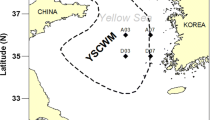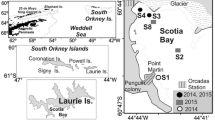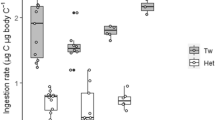Abstract
Deciphering the ontogenetic feeding ecology of copepods is essential to understanding their role in the energy transfer of marine ecosystems. We used stable isotope analysis to examine the ontogenetic feeding strategies of the four coexisting calanoid copepods, Mesocalanus tenuicornis, Metridia pacifica, Calanus sinicus, and Neocalanus plumchrus, in the East Sea (Japan Sea) in summer. Moreover, we used the stable carbon and nitrogen isotope composition of small-sized plankton in three cell size fractions, pico- (< 2 μm), nano- (2–20 μm) and microplankton (20–200 μm), to identify the dietary preference at each developmental stage. The relative carbon masses of pico-, nano- and microplankton were 18, 38, and 44%, respectively, and their δ13C and δ15N values gradually increased with increasing size classes. The ontogenetic trophic position of four copepods were relatively low and ranged from 2.1 to 2.6, indicating that herbivores feed on small-sized phytoplankton, pico- and nanoplankton. Among copepodid stages, the δ13C and δ15N values of M. tenuicornis and C. sinicus differed significantly, while those of M. pacifica and N. plumchrus were not significantly different. In M. tenuicornis, the smallest species among the four copepods examined, the diet preference of CIV for picoplankton changed to nanoplankton in the adult stage. When M. pacifica developed from CIV to adult, the diet preference changed from pico- to microplankton. The proportion of microplankton in the diet of C. sinicus and N. plumchrus increased from CIV to female adult and from CIII to CV, respectively. During the developmental progress in copepodid stages, the smaller copepods significantly changed their dietary preference from pico- to microplankton, while the larger copepods consistently fed on microplankton. We suggest that smaller copepods have an advantage in survival at early copepodid stages compared with larger copepods in summer when microplankton biomass is relatively low.
Similar content being viewed by others
References
Allan JD, Richman S, Heinle DR, Huff R (1977) Grazing in juvenile stages of some estuarine calanoid copepods. Mar Biol 43:317–331
Barber RT, Smith RL (1981) Coastal upwelling ecosystems. In Longhurst AR (ed) An analysis of marine ecosystems. Academic Press, New York, pp 31–68
Båmstedt U, Gifford DJ, Irigoien X, Atkinson A, Roman M (2000) Feeding. In Harris R, Wiebe P, Lenz J, Skjoldal HR, Huntley M (eds) ICES zooplankton methodology manual. Academic Press, London, pp 297–399
Banaru D, Carlotti F, Barani A, Grégori G, Neffati N, Harmelin-Vivien M (2014) Seasonal variation of stable isotope ratios of size-fractionated zooplankton in the Bay of Marseille (NW Mediterranean Sea). J Plankton Res 36:145–156
Bautista B, Harris RP (1992) Copepod gut contents, ingestion rates and grazing impact on phytoplankton in relation to size structure of zooplankton and phytoplankton during a spring bloom. Mar Ecol-Prog Ser 82:41–50
Bodin N, Loc F, Hily C (2007) Effect of lipid removal on carbon and nitrogen stable isotope ratios in crustacean tissues. J Exp Mar Biol Ecol 341:168–175
Bosley KL, Wainright SC (1999) Effects of preservatives and acidification on the stable isotope ratios (15N:14N, 13C:12C) of two species of marine animals. Can J Fish Aquat Sci 56:2181–2185
Chisholm SW (1992) Phytoplankton size. In Falkowski PG, Woodhead AD (eds) Primary productivity and biogeochemical cycles in the sea. Plenum Press, New York, pp 213–237
Choi DH, Noh JH, Hahm MS, Lee CM (2011) Picocyanobacterial abundances and diversity in surface water of the northwestern Pacific Ocean. Ocean Sci J 46:265–271
Choi DH, Noh JH, Shim J (2013) Seasonal changes in picocyanobacterial diversity as revealed by pyrosequencing in temperate waters of the East China Sea and the East Sea. Aquat Microb Ecol 71:75–90
Conway DVP (2006) Identification of the copepodite developmental stages of twenty-six North Atlantic copepods. Mar Biol Assoc UK 21:1–28
Davis AM, Blanchette ML, Pusey BJ, Jardine TD, Pearson RG (2012) Gut content and stable isotope analyses provide complementary understanding of ontogenetic dietary shifts and trophic relationships among fishes in a tropical river. Freshwater Biol 57:2156–2172
El-Sabaawi RW, Sastri AR, Dower JF, Mazumder A (2010) Deciphering the seasonal cycle of copepod trophic dynamics in the Strait of Georgia, Canada, using stable isotopes and fatty acids. Estuar Coast 33:738–752
Feuchtmayr H, Grey J (2003) Effect of preparation and preservation procedures on carbon and nitrogen stable isotope determinations from zooplankton. Rapid Commun Mass Sp 17:2605–2610
Frost BW (1972) Effects of size and concentration of food particles on feeding behavior of marine planktonic copepod Calanus pacificus. Limnol Oceanogr 17:805–815
Fry B, Sherr EB (1984) δ13C measurements as indicators of carbon flow in marine and freshwater ecosystems. Contrib Mar Sci 27:13–47
Fry F, Quiñones RB (1994) Biomass spectra and stable isotope indicators of trophic level in zooplankton of the northwest Atlantic. Mar Ecol-Prog Ser 112:201–204
Green EP, Harris RP, Duncan A (1991) The naupliar development of marine calanoid copepods under high and low food conditions. Bull Plankton Soc Japan Special Volume: 347–362
Hairston NG, Hairston NG (1993) Cause-effect relationships in the energy flows, trophic structure and interspecific interactions. Am Nat 142:379–411
Hannides CS, Popp BN, Landry MR, Graham BS (2009) Quantification of zooplankton trophic position in the North Pacific Subtropical Gyre using stable nitrogen isotopes. Limnol Oceanogr 54:50–61
Itoh K (1970) A consideration of feeding habits of planktonic copepods in relation to the structure of their oral parts. Bull Plankton Soc Japan 17:1–10
Kaehler S, Pakhomov EA (2001) Effects of storage and preservation on the δ13C and δ15N signatures of selected marine organisms. Mar Ecol-Prog Ser 219:299–304
Kawamura A (1982) Food habits and prey distributions of three rorqual species in the North Pacific Ocean. Sci Rep Whale Res Inst 34:59–91
Kim SL, Tinker MT, Estes JA, Koch PL (2012) Ontogenetic and among-individual variation in foraging strategies of Northeast Pacific White Sharks based on stable isotope analysis. PLoS ONE 7:e45068. doi: 10. 1371/journal.pone.0045068
Kiørboe T (1993) Turbulence, phytoplankton cell size, and the structure of pelagic food webs. Adv Mar Biol 29:1–72
Koppelmann R, Böttger-Schnack R, Möbius J, Weikert H (2009) Trophic relationships of zooplankton in the eastern Mediterranean based on stable isotope measurements. J Plankton Res 31:669–686
Kwak JH, Lee SH, Park HJ, Choy EJ, Jeong HD, Kim KR, Kang CK (2013) Monthly measured primary and new productivities in the Ulleung Basin as a biological "hot spot" in the East/Japan Sea. Biogeosciences 10:4405–4417
Kwak JH, Lee SH, Hwang J, Suh YS, Park HJ, Chang KI, Kim KR, Kang CK (2014) Summer primary productivity and phytoplankton community composition driven by different hydrographic structures in the East/Japan Sea and the Western Subarctic Pacific. J Geophys Res-Oceans 119:4505–4519
Landry MR, Fagerness VL (1988) Behavioral and morphological influences on predatory interactions among marine copepods. B Mar Sci 43:509–529
Letelier RM, Karl DM, Abbott MR, Bidigare RR (2004) Light driven seasonal patterns of chlorophyll and nitrate in the lower euphotic zone of the North Pacific Subtropical Gyre. Limnol Oceanogr 49:508–519
Lim JH, Son S, Park JW, Kwak JH, Kang CK, Son YB, Kwon JN, Lee SH (2012) Enhanced biological activity by an anticyclonic warm eddy during early spring in the East Sea (Japan Sea) detected by the geostationary ocean color satellite. Ocean Sci J 47:377–385
Liu H, Dagg MJ, Strom S (2005) Grazing by the calanoid copepod Neocalanus cristatus on the microbial food web in the coastal Gulf of Alaska. J Plankton Res 27:647–662
Malone TC (1980) Size-fractionated primary productivity of marine phytoplankton. In Falkowski PG (ed) Primary productivity in the sea. Plenum Press, New York, pp 301–319
Mauchline J (1998) The biology of calanoid copepods. Adv Mar Biol 33:1–710
Michener RH, Schell DM (1994) Stable isotopes ratios as tracers in marine aquatic food webs. In Lajtha K, Michener RH (eds) Stable isotopes in ecology and environmental sciences. Blackwell Scientific Publications, Oxford, pp 138–158
Minagawa M, Wada E (1984) Stepwise enrichment of 15N along food chains: further evidence and the relation between 15N and animal age. Geochim Cosmochim Ac 48:1135–1140
Mintenbeck K, Brey T, Jacob U, Knust R, Struck U (2008) How to account for the lipid effect on carbon stable-isotope ratio (d13C): sample treatment effects and model bias. J Fish Biol 72:815–830
Moku M, Kawaguchi K, Watanabe H, Ohno A (2000) Feeding habits of three dominant myctophid fishes, Diaphus theta, Stenobrachius leucopsarus and S. nannochir, in the subarctic and transitional waters of the western North Pacific. Mar Ecol-Prog Ser 207:129–140
Montoya JP, Holl CM, Zehr JP, Hansen A, Villareal TA, Capone DG (2004) High rates of N2 fixation by unicellular diazotrophs in the oligotrophic Pacific Ocean. Nature 430:1027–1031
Motwani NH, Gorokhova E (2013) Mesozooplankton grazing on picocyanobacteria in the Baltic Sea as inferred from molecular diet analysis. PLoS One 8:e79230. doi: 10.1371/journal.pone.0079230
Mullin MM (1969) Distribution, morphometry, and seasonal biology of the planktonic copepods Calanus tenuicornis and C. lighti, in the Pacific Ocean. Pac Sci 23:438–446
Park C, Choi JK (1997) Zooplankton community in the front zone of the East Sea of Korea (the Sea of Japan): 1. Species list, distribution of dominant taxa, and species association. J Korean Fish Soc 30:225–238
Park JI, Kang CK, Suh HL (2011) Ontogenetic diet shift in the euphausiid Euphausia pacifica quantified using stable isotope analysis. Mar Ecol-Prog Ser 429:103–109
Park JW, Nam SW, Kim HS, Youn SH, Yih W (2014) Enhanced photobiological H2 production by the addition of carbon monoxide and hydrogen cyanide in two unicellular N2-fixing cyanobacterial strains isolated from Korean coasts. Ocean Sci J 49:11–18
Parnell AC, Inger R, Bearhop S, Jackson AL (2010) Source partitioning using stable isotopes: coping with too much variation. PLoS One 5:e9672. doi: 10.1371/journal.pone.0009672
Parsons TR, LeBrasseur RJ (1970) The availability of food to different trophic levels in the marine food chain. In Steele JH (ed) Marine food chains. Oliver and Boyd, Edinburgh, pp 325–343
Pasternak AF (1994) Gut fluorescence in herbivorous copepods: an attempt to justify the method. Hydrobiologia 292/293: 241–248
Polito MJ, Reiss CS, Trivelpiece WZ, Patterson WP, Emslie SD (2013) Stable isotopes identify an ontogenetic niche expansion in Antarctic krill (Euphausia superba) from the South Shetland Islands, Antarctica. Mar Biol 160:1311–1323
Pond D, Harris R, Head R, Harbour D (1996) Environmental and nutritional factors determining seasonal variability in the fecundity and egg viability of Calanus helgolandicus in coastal waters off Plymouth, UK. Mar Ecol-Prog Ser 143:45–63
Rau GH, Teyssie JL, Rassoulzadegan F, Fowler SW (1990) 13C/12C and 15N/14N variations among size-fractionated marine particles: implications for their origin and trophic relationships. Mar Ecol-Prog Ser 59:33–38
Rau GH, Chavez FP, Friederich GE (2001) Plankton C13/C12 variations in Monterey Bay, California: evidence of nondiffusive inorganic carbon uptake by phytoplankton in an upwelling environment. Deep-Sea Res Pt I 48:79–94
Rho TK, Kim YB, Park JI, Lee YW, Im DH, Kang DJ, Lee TS, Yoon ST, Kim TH, Kwak JH, Park HJ, Jeong MK, Chang KI, Kang CK, Suh HL, Park MW, Lee HJ, Kim KR (2010) Plankton community response to physico-chemical forcing in the Ulleung Basin, East Sea during summer. Ocean Polar Res 32:269–289
Rolff C (2000) Seasonal variation in δ13C and δ15N of sizefractionated plankton at a coastal station in the northern Baltic proper. Mar Ecol-Prog Ser 203:47–65
Schmidt K, Atkinson A, Stü bing D, McClelland JW, Montoya JP, Voss M (2003) Trophic relationships among Southern Ocean copepods and krill: some uses and limitations of a stable isotope approach. Limnol Oceanogr 48:277–289
Smyntek PM, Teece MA, Schulz KL, Thackeray SJ (2007) A standard protocol for stable isotope analysis of zooplankton in aquatic food web research using mass balance correction models. Limnol Oceanogr 52:2135–2146
Sommer F, Sommer U (2004) d15N signatures of marine mesozooplankton and seston size fractions in Kiel Fjord, Baltic Sea. J Plankton Res 26:495–500
Syväranta J, Vesala S, Rask M, Ruuhijä rvi J, Jones RI (2008) Evaluating the utility of stable isotope analyses of archived freshwater sample materials. Hydrobiologia 600:121–130
Tang EPY (1995) The allometry of algal growth rates. J Plankton Res 17:1325–1335
Turner JT (1984) Zooplankton feeding ecology: contents of fecal pellets of the copepods Temora turbinata and T. stylifera from continental shelf and slope waters near the mouth of the Mississippi River. Mar Biol 82:73–83
Vander Zanden MJ, Rasmussen JB (2001) Variation in δ15N and δ13C trophic fractionation: implications for aquatic food web studies. Limnol Oceanogr 46:2061–2066
Vargas CA, Martínez RA, González HE, Silva N (2008) Contrasting trophic interactions of microbial and copepod communities in a fjord ecosystem, Chilean Patagonia. Aquat Microb Ecol 53:227–242
Vidal J (1980) Physioecology of zooplankton. I. Effects of phytoplankton concentration, temperature, and body size on the growth rate of Calanus pacificus and Pseudocalanus sp. Mar Biol 56:111–134
Wilson SE, Steinberg DK (2010) Autotrophic picoplankton in mesoplankton guts: evidence of aggregate feeding in the mesopelagic zone and export of small phytoplankton. Mar Ecol-Prog Ser 412:11–27
Author information
Authors and Affiliations
Corresponding author
Rights and permissions
About this article
Cite this article
Im, DH., Wi, J.H. & Suh, HL. Evidence for ontogenetic feeding strategies in four calanoid copepods in the East Sea (Japan Sea) in summer, revealed by stable isotope analysis. Ocean Sci. J. 50, 481–490 (2015). https://doi.org/10.1007/s12601-015-0044-y
Received:
Revised:
Accepted:
Published:
Issue Date:
DOI: https://doi.org/10.1007/s12601-015-0044-y




